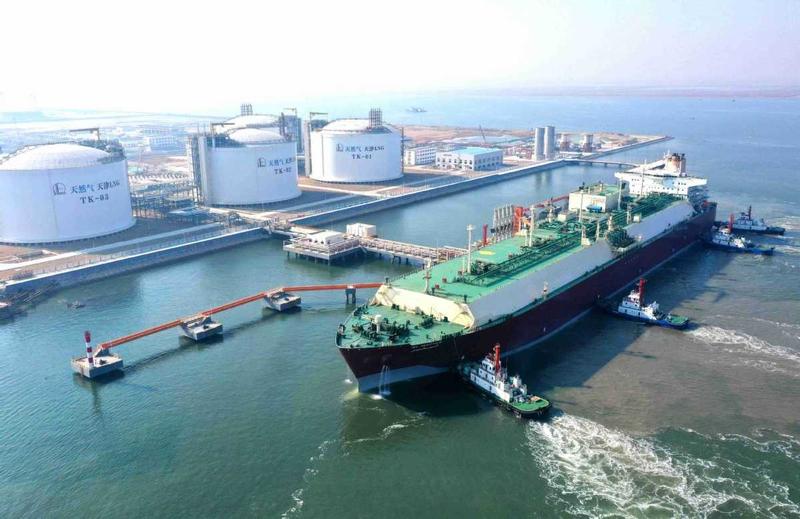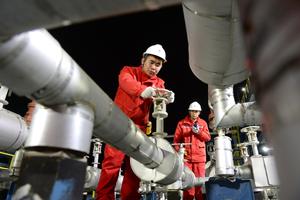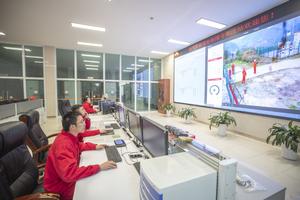 A liquefied natural gas (LNG) tanker from Qatar docks at a Sinopec Group port in Tianjin in November 2020. As a major strategic partner in the energy sector, Qatar has supplied millions of tons of LNG to China since 2009. (HU QINGMING / FOR CHINA DAILY)
A liquefied natural gas (LNG) tanker from Qatar docks at a Sinopec Group port in Tianjin in November 2020. As a major strategic partner in the energy sector, Qatar has supplied millions of tons of LNG to China since 2009. (HU QINGMING / FOR CHINA DAILY)
China has led the recovery in liquefied natural gas (LNG) demand following the outbreak of the COVID-19 pandemic, and is expected to further boost LNG demand, as the country pledges solid efforts to peak carbon emissions and achieve carbon neutrality.
The country, on course to become the world's biggest importer of LNG, increased imports by 7 million metric tons to 67 million tons last year, up 11 percent year-on-year, according to the recently released annual LNG Outlook by Royal Dutch Shell.
China's announcement that it aims to become carbon neutral by 2060 is also expected to continue driving its LNG demand given the key role gas can play in decarbonizing hard-to-abate sectors, including buildings, heavy industry, shipping and heavy-duty road transport, said the report.
The role of natural gas in China's road to carbon neutrality in 2060 is critical, and increasing the share of natural gas in the primary energy mix is expected to lead to China's natural gas consumption increasing 58 percent by 2030 compared with 2020.
Cao Lujia, analyst at BloombergNEF
This is against the backdrop that global LNG trade increased to 360 million tons in 2020 despite the unprecedented volatility caused by the COVID-19 pandemic that resulted in lockdowns around the world.
The trend is only expected to continue. According to a forecast by energy consultancy ICIS, China is expected to import between 4.7 million tons and 5.3 million tons of LNG per month between February and April, on average a 12 percent increase compared to the corresponding months last year.
On an annual basis, the consultancy forecast that China will import 76 million tons this year, an 13 percent year-on-year increase.
Analysts believe China's gas demand has recovered faster than expected after the pandemic, driven mostly by the industrial sector. The deal-making environment for LNG is also quite bright this year with the domestic economy roaring back to life.
Cao Lujia, an analyst at BloombergNEF, said: "Demand for LNG used in heating and power generation is growing notably faster than that for any other fossil fuel as the nation looks for a cheap, reliable and cleaner alternative to coal.
ALSO READ: Sinopec: Tianjin LNG terminal expansion on track
"The role of natural gas in China's road to carbon neutrality in 2060 is critical, and increasing the share of natural gas in the primary energy mix is expected to lead to China's natural gas consumption increasing 58 percent by 2030 compared with 2020.
"China topped the major markets in terms of demand growth last year, despite the pandemic, and the northern parts of China made up 39 percent of total gas demand in 2020."
 Sinopec technicians conduct safety checks on LNG transport equipment in Tianjin in November, 2020. (HU QINGMING / FOR CHINA DAILY)
Sinopec technicians conduct safety checks on LNG transport equipment in Tianjin in November, 2020. (HU QINGMING / FOR CHINA DAILY)
Aiming to increase the share of natural gas in the primary energy mix to 15 percent by 2030 from around 8 percent in 2019, China has already been reducing carbon emissions by replacing coal and oil with natural gas in certain areas including residential heating and heavy-duty commercial vehicles. This is also in accordance with the government's priority of improving air quality.
China mainly imported LNG from countries including Australia, Qatar and Malaysia, which sold 29 million tons, 8 million tons and 6 million tons of LNG to China last year, respectively, with sales value reaching US$10.3 billion, US$3.4 billion and US$1.8 billion, data from the General Administration of Customs showed.
Beijing imported the most LNG last year, 35.13 million tons worth US$12.5 billion, followed by Jiangsu province's 8.13 million tons at US$3.1 billion and Guangdong province's 4.2 million tons at US$1.2 billion.
Cao said that while increased natural gas usage at the expense of coal and oil will help reduce China's carbon emissions, the Chinese government is unlikely to rely on imported gas to achieve meaningful decarbonization or carbon neutrality, unlike the United States, which has abundant domestic gas supplies that have helped lower its emissions.
ALSO READ: LNG: ExxonMobil inks deal with Zhejiang Energy for 1m tons
"Experience from European countries shows that biomethane and hydrogen are a crucial next-step to enable long-term climate goals to be reached. The emissions intensity of natural gas can also be lowered substantially with carbon capture use and storage technologies, or CCUS. A combination of these three approaches will help the natural gas industry evolve and deliver low-carbon growth," she added.
China's opening-up of LNG terminals to third parties will also encourage more participants to get involved in the LNG import sector.
China Oil & Gas Piping Network Corp (PipeChina), China's largest energy infrastructure company-created in 2020 amid the country's largest gas market reform in decades-launched a website platform in late October that allows all third parties to register as certified shippers and apply for pipeline transmission and LNG import capacity. Some 1,000 shippers had applied for certification on the platform by the Oct 20 deadline, it said.
Compared with countries including Japan and South Korea, China has a long way to go in stepping up the utilization rate of coastal land resources and operational costs, and the government should prioritize extending the capacity of existing LNG terminals to further raise the gas storage facilities' utilization rate, said Liu Ping with CNOOC (Hainan) Fudao Chemical Ltd
With original intent to liberalize China's natural gas market and allow more market participants to access LNG infrastructure facilities, PipeChina allows other companies in addition to the countries' top three oil majors-China National Petroleum Corp, China Petroleum &Chemical Corp and China National Offshore Oil Corp (CNOOC)-to be able to use its terminal slot and import LNG without having to build their own terminals, which in turn lowers barriers to entry in the Chinese gas market.
PipeChina last year began its role as the operator of six existing LNG terminals that were transferred from China National Offshore Oil Corp (CNOOC) and China Petroleum & Chemical Corp.
In the last quarter of 2020, the number of new entities accessing the terminals as part of the third-party access initiative had led to increasing terminal imports at Diefu and Yuedong terminals in Guangdong province, said BloombergNEF.
Six new users at Diefu terminal, which included power and gas utilities and local gas trading companies, contributed to 36 percent of total terminal imports in the fourth quarter of last year, it said.
Many Chinese power and gas utilities entered the market last year, starting with spot LNG cargo purchases, signing term contracts to secure long-term supplies.
Guangdong Energy signed a five-year deal with Mitsubishi's Diamond Gas for four cargoes of gas a year, with Shenzhen Energy to receive a third of the gas. As a result, Dapeng LNG terminal registered a 17 percent year-on-year growth in imports, thanks to third-party access utilization for stakeholders such as Guangdong Energy and Guangzhou Gas.
"This year, PipeChina will further consolidate midstream gas assets and provide third-party access and more new players are expected to enter the market. This could further boost LNG demand," Cao said.
 China National Petroleum Corp technicians monitor an LNG storage operation site in Chongqing on March 14, 2021. (PHOTO / XINHUA)
China National Petroleum Corp technicians monitor an LNG storage operation site in Chongqing on March 14, 2021. (PHOTO / XINHUA)
Some new contracts signed by nonnational oil companies also began this year, including Foran Energy and ENN's deal with BP for 600,000 million tons of LNG supply each, with deliveries starting this year.
Liu Ping with CNOOC (Hainan) Fudao Chemical Ltd, who is also a deputy to the 13th National People's Congress, said it was necessary for the country to step up infrastructure facility construction to ensure sufficient energy supply.
Compared with other energy storage facilities, the LNG terminals enjoy rapid construction speed and flexible and convenient storage. While the country is already rapidly building up its LNG terminal construction, it still lags far behind the global average, he said.
After the Dapeng LNG terminal was constructed in 2006 by CNOOC, the country had 22 LNG terminals nationwide by the end of 2020, including six operated by PipeChina, five by CNOOC, five operated by nonnational oil companies including local SOEs and private companies, four operated by China National Petroleum Corp and two by China Petroleum & Chemical Corp. Total capacity reached 86 million tons per year, according to BloombergNEF.
However, compared with countries including Japan and South Korea, China has a long way to go in stepping up the utilization rate of coastal land resources and operational costs, and the government should prioritize extending the capacity of existing LNG terminals to further raise the gas storage facilities' utilization rate, Liu said.
CNOOC, as a pioneer of China's LNG sector that built the nation's first LNG terminal in 2006, vowed to further diversify its overseas LNG sources to further ensure supplies.
It signed a memorandum of understanding with Malaysia's state oil firm Petronas on March 15 for further collaboration across the supply chain, including refining, oilfield and engineering services, specialty chemicals, lubricants and renewable energy, based on their current relationship in LNG and upstream projects.
Being the country's largest offshore oil and gas producer, CNOOC will also intensify collaboration with Petronas, the world's fourth-biggest LNG exporter, in the establishment of a global bunkering supply network and expansion of the use of natural gas as a cleaner marine fuel through LNG bunkering solutions.
READ MORE: CNOOC confirms massive oil discovery in Bohai Bay
With an annual receiving capacity of 29.6 million tons at its Shanghai LNG terminal, Zhuhai LNG terminal, Dapeng LNG terminal, Fujian LNG terminal as well as Zhejiang LNG terminal, the company is currently the country's biggest LNG importer and the world's third largest. It aims to set up more LNG terminals in Fujian and Zhejiang provinces to increase its receiving capacity.


